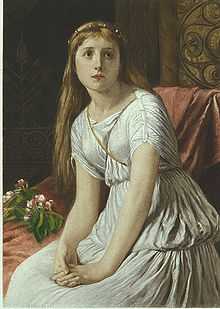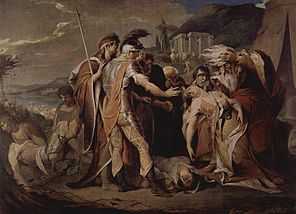Codelia (King Lear)
| Cordelia | |
|---|---|
 Cordelia, by William Frederick Yeames | |
| Creator | William Shakespeare |
| Play | King Lear |
Cordelia is a fictional character in William Shakespeare’s tragic play, King Lear. She is the youngest of King Lear’s three daughters, and his favourite. After her elderly father offers her the opportunity to profess her love to him in return for one third of the land in his kingdom, she refuses and is banished for the majority of the play.
Origin
Shakespeare had numerous resources to consult while writing King Lear. The oldest source in print was Geoffrey of Monmouth’s The History of the Kings of Britain, c.1136.[1] This is the earliest written record of Cordelia. Here she is depicted as Queen Cordelia.
Role in play

Introduction
In Shakespeare’s King Lear, Cordelia is briefly on stage during the first act, to return only in Act 4, scene 4. Her exile is a result of her honest, yet unacceptable response to her father’s question in Act 1, scene 1. When Lear is dividing the land of his kingdom, Cordelia's sisters, Goneril and Regan, give deceitfully lavish speeches professing their love, a demonstration in which Cordelia will not partake (she sees right through her sister's professions). She will not give a superfluous answer, the one she presents ("Love, and be silent" 1.1.62) being deemed too simple, notwithstanding its depth.[2] Lear asks her, “What can you say to draw / A third more opulent than your sisters? Speak.” (1.1.84-5). Cordelia replies, “Nothing, my lord.” (1.1.86). She continues, “Unhappy that I am, I cannot heave / My heart into my mouth. I love your majesty / According to my bond; no more nor less.” (1.1 90-2). Cordelia’s ability to differentiate love from property is far different from her father’s. Outraged and humiliated, Lear banishes Cordelia from the kingdom.[3]

The ending

Cordelia is Lear’s favorite daughter and is often compared to a Cinderella character, in that she loses a slipper at the end. After Lear is rejected by Goneril and Regan, the wicked sisters, he goes mad. Cordelia returns at the end of the play with the intentions of helping him, ultimately reversing her role as daughter to mother.[4] But when she arrives, he doesn’t even recognize her. Nevertheless, she forgives him for banishing her. By the time Lear finally regains his reason and realizes who Cordelia is, they have little time to talk and reconcile; Edmund arrives and sends them to prison, where Cordelia is ultimately hanged. In Nahum Tate's revision The History of King Lear (1681), which replaced Shakespeare's original version for decades, Cordelia marries Edgar and becomes ruler of the kingdom.[5]
Performance on screen
- Romola Garai. King Lear (2009) PBS Dir. Sir Trevor Nunn and Chris Hunt
- Phillipa Peak. King Lear (1999) Dir. Brian Blessed & Tony Rotherham
- Victoria Hamilton. Performance King Lear (1998) Dir. Richard Eyre
- Anna Calder-Marshall. King Lear (1983) (TV) Dir. Michael Elliott
- Brenda Blethyn. King Lear (1982) (TV) Dir. Jonathan Miller
- Wendy Allnutt. King Lear (1976) (TV) Dir. Tony Davenall
- Lee Chamberlin. King Lear (1974) (TV) Dir. Edwin Sherin
- Anne-Lise Gabold. King Lear (1971 UK Film) Dir. Peter Brook
- Valentina Shendrikova. Korol Lir (1971 USSR Film) Dir. Grigori Kozintsev & Iosif Shapiro
- Natasha Parry. King Lear (1953) (TV) Dir. Andrew McCullough
Further reading
- Smiley, Jane. A Thousand Acres. Ivy Books, 1996. Print.
- Fischlin, Daniel and Fortier, Mark. Adaptations of Shakespeare. Feinstein, Elain and the Women’s Theatre Group. Lear’s Daughters. 215-232. Routledge, 2000. Print
- Hamilton, Sharon. "Shakespeare's Daughters". 151-175. McFarland & Company, 2003. Print
References
- ↑ Milton, John. The History of Britain. Complete Prose Works of John Milton. Volume V. New Haven and London: Yale University Press. 1648-1671.
- ↑ Milard, Barbara C. Virago with a Soft Voice: Cordelia’s Tragic Rebellion in King Lear. Philosophical Quarterly 68.2 (1989): Gale Literature Resources Center. Web 25 March 2010.
- ↑ Shakespeare, William. King Lear. The Norton Shakespeare: Tragedies. Ed. Greenblatt, Cohen, Howard, Maus. W.W Norton and Company, 1997. pp. 707-781.
- ↑ McFarland, Thomas. The Image of Family in King Lear. Shakespearean Criticism Vol. 73. 2003. Gale Literature Resources Center, Web. 25 March 2010.
- ↑ Spencer, Christopher. Five Restoration Adaptations of Shakespeare. Tate, Nahum. The History of King Lear. University of Illinois Press, 1965. pp. 203-274.
External links
- PBS Production of King Lear
- King Lear Films
- King Lear Video Clips on YouTube
- The True Chronicle Historie of King Leir Text (1605) by Anonymous
- The History of King Lear (1681) by Nahum Tate
| ||||||||||||||||||||||||||||||||||||||||||||||||||||
